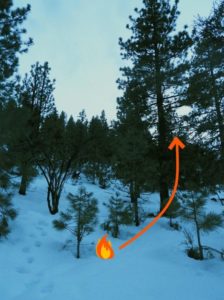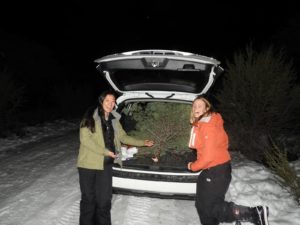A “Tree-Mendous” Way to Improve Forest Health
March 18th, 2020(Originally posted December 2019)
Growing up in Southern California deprived me of the opportunity to harvest my own Christmas tree from the forest. To embrace my Northern Nevada residency, I decided to take my friends Joseph and Deborah, who were also new to the experience, to find the perfect Christmas tree. I was excited about starting a new Christmas tradition and I also knew that this process benefits the forests by thinning out smaller trees. With a sense of adventure and Christmas spirit, we decided to embark on this tree-finding outing.
The first step we took was purchasing a permit for a tree. The two places in Reno where people can go to get a permit for cutting down a tree in a wilderness area are the Bureau of Land Management (BLM) office and the U.S. Forest Service office. We originally headed to the BLM office in Reno to learn more about the process. BLM offers permits for Utah Junipers and Pinyon Pines. Apparently, Pinyon Pines leak sap once they are warmed up, and could potentially ruin furniture and carpet. Popular tree cutting areas on BLM land are mostly east of Highway 395 and south of Carson City which was a bit too far of a drive for our short time frame. The officer recommended we go to the U.S. Forest Service office, which was located a five-minute drive away. U.S. Forest Service land is mostly west of Highway 395 and they offer permits for different species of trees, including White Fir, Jeffrey Pine and Incense Cedar. We rushed over and secured a permit for $10 (which came with the lovely treat of a candy cane).
With the informational packet and permit in hand, we drove down towards Mt. Rose Wilderness, which is part of U.S. Forest Service Land. After looking at the map of permitted cutting areas, we decided to drive to Thomas Creek off of Mt. Rose Highway. We parked the car and hiked into the wilderness, lugging a sled to carry a saw, rope, tape measure, camera, headlamps and the permit packet. Knowing we were about to face cold and snowy conditions, we dressed appropriately with waterproof and warm clothes. We set off into the wilderness in hopes of finding a tree before dark.
The permit required that the tree we cut down fit certain specifications, and finding a tree that met the requirement turned out to be quite difficult. The tree had to be the correct species, no bigger than 6 inches in diameter at the base, and within 10 feet of another living tree. We searched up and down steep snowy hills while post-holing through fresh snow, before venturing towards Thomas Creek where we spotted a small White Fir in a clump of trees. I wanted to make sure we got a fresh tree so I ran my hand down a branch; if the needles stay intact and connected to the branch, it is a good indication of freshness. Not a single needle came off so we knew that this 6-foot White Fir with a 4-inch diameter trunk was the perfect tree.
All that was left to do was to cut it down and take it home. Using a hand saw, we cut the tree and made sure the stump left behind was no taller than 6 inches, with no live branches left on the stump. We attached the permit to the tree and tried to carry the tree on the sled. Turns out the sled was too small, so Joseph carried the tree on his shoulder all the way back to the car (Thanks Joe!). As we hiked back, we overlooked a beautiful sunset. The tree fit snugly inside the car with the seats down and we drove cautiously back to my home in Reno. Upon our return, we sliced an additional 2 inches off the bottom, as a freshly cut tree soaks up water faster. We mounted our tree on a tree stand and added half a gallon of lukewarm water to the stand. Adding water that is too cold can potentially shock the tree. We found a place for the tree that was away from the fireplace, windows and heaters to prevent it from drying out. Feeling accomplished, we looked proudly upon our unique tree.
Harvesting a Christmas tree turned out to be such a festive and enjoyable experience to share with friends and family. I highly recommend it, not only because it is a great tradition, but also because it’s ecologically beneficial for the forest. Due to successful wildfire suppression efforts, there are more trees in the forest. Harvesting trees that meet permit specifications reduces the fuel loading in the forest by thinning out the smaller trees. This allows mid-size and large trees to grow big and strong. Reducing the smaller trees also reduces risky “ladder fuels”. A ladder fuel is vegetation that can carry a fire from low-growing plants to taller plants.

An example of a ladder fuel
Eliminating the low-growing small trees reduces the threat of wildfire spreading to taller plants. Looking back on the experience, I had a great time trying something new. Our Christmas tree is full of character and holds a special memory of the adventure. I also contributed to maintaining a healthy forest, and that is the cherry on top of the holiday cheer.
Lauren and Deborah pose next to the tree.
If you would like to obtain a tree-cutting permit through BLM or the U.S Forest Service, view their links here:
Humboldt-Toiyabe National Forest Christmas Tree Permit Information
Bureau of Land Management Christmas Tree Permit Information
 Lauren Im is the Wildfire Outreach Coordinator Assistant for the Living With Fire program. She is serving a term with the Great Basin Institute as an Americorps State and National Program volunteer. She earned her Bachelors of Science in Biology and is currently obtaining a Geographical Information Systems certificate. She also enjoys rock-climbing, skiing, and being with friends and family.
Lauren Im is the Wildfire Outreach Coordinator Assistant for the Living With Fire program. She is serving a term with the Great Basin Institute as an Americorps State and National Program volunteer. She earned her Bachelors of Science in Biology and is currently obtaining a Geographical Information Systems certificate. She also enjoys rock-climbing, skiing, and being with friends and family.

